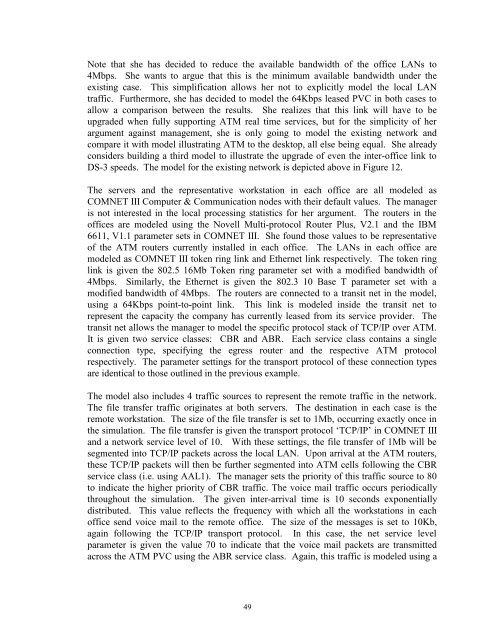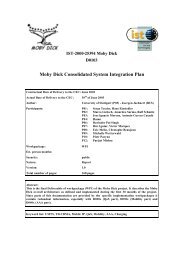COMNET III CACI
COMNET III CACI
COMNET III CACI
Create successful ePaper yourself
Turn your PDF publications into a flip-book with our unique Google optimized e-Paper software.
Note that she has decided to reduce the available bandwidth of the office LANs to<br />
4Mbps. She wants to argue that this is the minimum available bandwidth under the<br />
existing case. This simplification allows her not to explicitly model the local LAN<br />
traffic. Furthermore, she has decided to model the 64Kbps leased PVC in both cases to<br />
allow a comparison between the results. She realizes that this link will have to be<br />
upgraded when fully supporting ATM real time services, but for the simplicity of her<br />
argument against management, she is only going to model the existing network and<br />
compare it with model illustrating ATM to the desktop, all else being equal. She already<br />
considers building a third model to illustrate the upgrade of even the inter-office link to<br />
DS-3 speeds. The model for the existing network is depicted above in Figure 12.<br />
The servers and the representative workstation in each office are all modeled as<br />
<strong>COMNET</strong> <strong>III</strong> Computer & Communication nodes with their default values. The manager<br />
is not interested in the local processing statistics for her argument. The routers in the<br />
offices are modeled using the Novell Multi-protocol Router Plus, V2.1 and the IBM<br />
6611, V1.1 parameter sets in <strong>COMNET</strong> <strong>III</strong>. She found those values to be representative<br />
of the ATM routers currently installed in each office. The LANs in each office are<br />
modeled as <strong>COMNET</strong> <strong>III</strong> token ring link and Ethernet link respectively. The token ring<br />
link is given the 802.5 16Mb Token ring parameter set with a modified bandwidth of<br />
4Mbps. Similarly, the Ethernet is given the 802.3 10 Base T parameter set with a<br />
modified bandwidth of 4Mbps. The routers are connected to a transit net in the model,<br />
using a 64Kbps point-to-point link. This link is modeled inside the transit net to<br />
represent the capacity the company has currently leased from its service provider. The<br />
transit net allows the manager to model the specific protocol stack of TCP/IP over ATM.<br />
It is given two service classes: CBR and ABR. Each service class contains a single<br />
connection type, specifying the egress router and the respective ATM protocol<br />
respectively. The parameter settings for the transport protocol of these connection types<br />
are identical to those outlined in the previous example.<br />
The model also includes 4 traffic sources to represent the remote traffic in the network.<br />
The file transfer traffic originates at both servers. The destination in each case is the<br />
remote workstation. The size of the file transfer is set to 1Mb, occurring exactly once in<br />
the simulation. The file transfer is given the transport protocol ‘TCP/IP’ in <strong>COMNET</strong> <strong>III</strong><br />
and a network service level of 10. With these settings, the file transfer of 1Mb will be<br />
segmented into TCP/IP packets across the local LAN. Upon arrival at the ATM routers,<br />
these TCP/IP packets will then be further segmented into ATM cells following the CBR<br />
service class (i.e. using AAL1). The manager sets the priority of this traffic source to 80<br />
to indicate the higher priority of CBR traffic. The voice mail traffic occurs periodically<br />
throughout the simulation. The given inter-arrival time is 10 seconds exponentially<br />
distributed. This value reflects the frequency with which all the workstations in each<br />
office send voice mail to the remote office. The size of the messages is set to 10Kb,<br />
again following the TCP/IP transport protocol. In this case, the net service level<br />
parameter is given the value 70 to indicate that the voice mail packets are transmitted<br />
across the ATM PVC using the ABR service class. Again, this traffic is modeled using a<br />
49
















